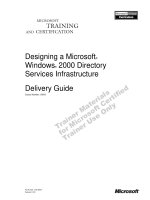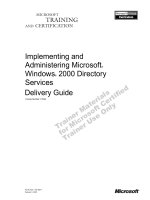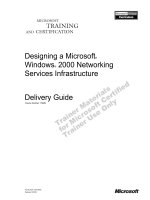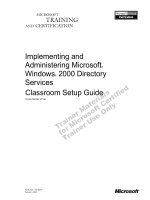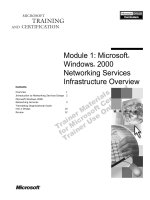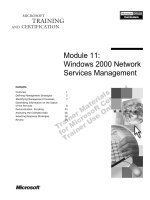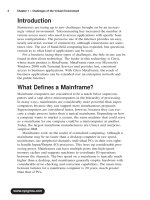windows azure mobile services
Bạn đang xem bản rút gọn của tài liệu. Xem và tải ngay bản đầy đủ của tài liệu tại đây (4.59 MB, 160 trang )
www.it-ebooks.info
www.it-ebooks.info
WINDOWS AZURE
®
MOBILE SERVICES
INTRODUCTION . . . . . . . . . . . . . . . . . . . . . . . . . . . . . . . . . . . . . . . . . . . . . . . . . . . . . . . . . xv
CHAPTER 1 Introduction and Fundamental Concepts . . . . . . . . . . . . . . . . . . . . . . 1
CHAPTER 2 Creating and Manipulating Data . . . . . . . . . . . . . . . . . . . . . . . . . . . . . 17
CHAPTER 3 Mobile Services Validation . . . . . . . . . . . . . . . . . . . . . . . . . . . . . . . . . .39
CHAPTER 4 Authentication Options in WAMS . . . . . . . . . . . . . . . . . . . . . . . . . . . . 58
CHAPTER 5 Using REST to Access WAMS Data . . . . . . . . . . . . . . . . . . . . . . . . . . . . 79
CHAPTER 6 Push Notifi cations . . . . . . . . . . . . . . . . . . . . . . . . . . . . . . . . . . . . . . . . . 93
CHAPTER 7 Advanced Scripting . . . . . . . . . . . . . . . . . . . . . . . . . . . . . . . . . . . . . . . 107
CHAPTER 8 Advanced Confi guration . . . . . . . . . . . . . . . . . . . . . . . . . . . . . . . . . . . 126
www.it-ebooks.info
www.it-ebooks.info
Windows Azure
®
Mobile Services
www.it-ebooks.info
www.it-ebooks.info
Windows Azure
®
Mobile Services
Bruce Johnson
www.it-ebooks.info
Windows Azure
®
Mobile Services
Published by
John Wiley & Sons, Inc.
10475 Crosspoint Boulevard
Indianapolis, IN 46256
www.wiley.com
Copyright © 2013 by John Wiley & Sons, Inc., Indianapolis, Indiana
ISBN: 978-1-118-67853-4 (ebk)
ISBN: 978-1-118-74991-3 (ebk)
Manufactured in the United States of America
No part of this publication may be reproduced, stored in a retrieval system or transmi ed in any form or by any means, elec-
tronic, mechanical, photocopying, recording, scanning or otherwise, except as permi ed under Sections 107 or 108 of the 1976
United States Copyright Act, without either the prior wri en permission of the Publisher, or authorization through payment
of the appropriate per-copy fee to the Copyright Clearance Center, 222 Rosewood Drive, Danvers, MA 01923, (978) 750-8400,
fax (978) 646-8600. Requests to the Publisher for permission should be addressed to the Permissions Department, John Wiley &
Sons, Inc., 111 River Street, Hoboken, NJ 07030, (201) 748-6011, fax (201) 748-6008, or online at />permissions.
Limit of Liability/Disclaimer of Warranty: e publisher and the author make no representations or warranties with respect
to the accuracy or completeness of the contents of this work and specifi cally disclaim all warranties, including without limitation
warranties of fi tness for a particular purpose. No warranty may be created or extended by sales or promotional materials. e
advice and strategies contained herein may not be suitable for every situation. is work is sold with the understanding that the
publisher is not engaged in rendering legal, accounting, or other professional services. If professional assistance is required, the
services of a competent professional person should be sought. Neither the publisher nor the author shall be liable for damages aris-
ing herefrom. e fact that an organization or Web site is referred to in this work as a citation and/or a potential source of further
information does not mean that the author or the publisher endorses the information the organization or Web site may provide or
recommendations it may make. Further, readers should be aware that Internet Web sites listed in this work may have changed or
disappeared between when this work was wri en and when it is read.
For general information on our other products and services please contact our Customer Care Department within the United
States at (877) 762-2974, outside the United States at (317) 572-3993 or fax (317) 572-4002.
Trademarks: Wiley, the Wiley logo, Wrox, the Wrox logo, Programmer to Programmer, and related trade dress are trademarks
or registered trademarks of John Wiley & Sons, Inc. and/or its affi liates, in the United States and other countries, and may not be
used without wri en permission. Windows Azure is a registered trademark of Microso Corporation. All other trademarks are
the property of their respective owners. John Wiley & Sons, Inc., is not associated with any product or vendor mentioned in this
book.
ACQUISITIONS EDITOR
Mary James
PROJECT EDITOR
Edward Connor
TECHNICAL EDITOR
Wouter van Eck
PRODUCTION EDITOR
Christine Mugnolo
COPY EDITOR
Kim Cofer
EDITORIAL MANAGER
Mary Beth Wakefi eld
FREELANCE EDITORIAL
MANAGER
Rosemarie Graham
ASSOCIATE DIRECTOR OF
MARKETING
David Mayhew
MARKETING MANAGER
Ashley Zurcher
VICE PRESIDENT AND EXECUTIVE
GROUP PUBLISHER
Richard Swadley
VICE PRESIDENT AND EXECUTIVE
PUBLISHER
Neil Edde
ASSOCIATE PUBLISHER
Jim Minatel
PROOFREADER
James Saturnio, Word One New York
COVER DESIGNER
Ryan Sneed
www.it-ebooks.info
I’d like to thank my wife, Ali, and my four children, Curtis,
Gillian, Cameron, and Kyle, for their love and support. ࡍ ey
patiently put up with my lack of time whenever I tackle a
book project, and for that I am truly grateful. And this time
around, I have to include Hershey in the dedication. So say
my kids . . . and what they say goes
.
– Bruce Johnson.
www.it-ebooks.info
ABOUT THE AUTHOR
BRUCE JOHNSONɄis a partner at ObjectSharp Consulting and a 30-year veteran of the computer
industry. ॡ e fi rst third of his career was spent doing “real work,” otherwise known as coding
in the UNIX world. But for almost 20 years, he has been working on projects that are at the
leading edge of Windows technology, from C++ through Visual Basic to C#, and from thick client
applications to websites to services.
As well as having fun with building systems, Bruce has spoken hundreds of times at conferences
andbuser groups throughout North America. He has been a Microso॑ Certifi ed Trainer (MCT)
for the past three years and he is a co-president of the Metro Toronto .NET User Group. He has
wri॔ enbcolumns and articles for numerous magazines. While the quantity of the posts on his blog
(
have decreased recently, the activity on his Twi॔ er
account (
has shown a corresponding increase. For all of
thisbactivity (or, perhaps, in spite of it), Bruce has been privileged to be recognized as a Microso॑
MVP for the past six years.
ABOUT THE TECHNICAL EDITOR
WOUTER VAN ECKɄis a so॑ ware design and development consultant specializing in cloud
integration with a strong focus on the Microso॑ platform. In the past fi ve years or so, Wouter has
focused on what we now call “the cloud” as the base for integration work backed by the Microso॑
Azure technology. With successful deployments in Canada, the United States, Germany, and
Singapore, Wouter has demonstrated true cloud experience.
www.it-ebooks.info
ACKNOWLEDGMENTS
THE WRITING OF A BOOKɄis much more of a collaborative e ort than might be apparent to an
outsider. I have wri॔ en a number of books and I can guarantee you that there is no way a single
one of those books would have seen the light of day without a great deal of assistance from
many other people. ॡ ere are a surprising number of people involved in the editorial process,
and odds are pre॔ y good that if you can understand the content of the book, that my editor, my
technical reviewer, and my copy editor are the reason why. My fi rst dra॑ is not something that
should be read by anyone, and these people shape the pages so that the result is something that can
be read by everyone. ॡ at is not an easy task, and I am indebted to them for their assistance.
I would especially like to thank everyone at Wrox who has helped me through this process. In
particular, thanks go out to Ed Connor, whose patience and a॔ ention to detail is quite impressive.
ॡ anks also go to Wouter van Eck, who did a great job making sure that the technical details of
thebbook were accurate. Finally, thanks to Kim Cofer, who had the unenviable chore of ensuring
that I wasn’t writing in the passive voice, and fi xing it when I stopped writing so well. ॡ e e orts
of all of these individuals are what make the book possible and, hopefully, a success. ॡ anks also
to Mary James, who was kind enough to allow me to indulge my passion to write.
Lastly, I would like to thank all of my associates at ObjectSharp and the people at Microso॑ who,
although they might not have realized it, were keeping the writing process going by answering
any questions I had.
—ۓBruce Johnson
www.it-ebooks.info
www.it-ebooks.info
CONTENTS
INTRODUCTION TO THE WINDOWS AZUREbBOOK SERIES xv
INTRODUCTION TO WINDOWS AZURE MOBILE SERVICES xvii
CHAPTER 1: INTRODUCTION AND FUNDAMENTAL CONCEPTS 1
What Is Azure? 2
A Brief History of Azure 2
Windows Azure Features 3
Execution Model 3
Data Storage 5
Connectivity 6
Authentication 7
Messaging 8
And Now, Back to Our Show 8
Setting Up WAMS 9
Generating a Sample Application 13
Summary 16
CHAPTER 2: CREATING AND MANIPULATING DATA 17
The Data Model 18
Client-Side Functionality 26
Summary 38
CHAPTER 3: MOBILE SERVICES VALIDATION 39
Adding Server-Side Scripts 39
Inserting Data 42
Updating Data 43
Deleting Data 44
Retrieving Data 45
The User Object 47
Common Scenarios 48
Summary 57
www.it-ebooks.info
xii
CONTENTS
CHAPTER 4: AUTHENTICATION OPTIONS IN WAMS 58
Federated Authentication 58
Setting Up the Authentication Providers 61
Confi guring Your Service for Authentication 72
Authentication on the Client Side 74
Troubleshooting Authentication 77
Summary 78
CHAPTER 5: USING REST TO ACCESS WAMS DATA 79
Representational State Transfer 79
GET 80
POST 80
PUT 81
DELETE 81
REST and WAMS 82
Authentication in REST 88
Summary 92
CHAPTER 6: PUSH NOTIFICATIONS 93
Registering Your Application 95
Windows Notifi cation Services 95
Google Cloud Messaging 98
Apple Push Notifi cation Services 99
Confi guring Your Mobile Service 100
The Mechanics of Push Notifi cations 101
Requesting a Channel 101
Sending Notifi cations 104
Summary 106
CHAPTER 7: ADVANCED SCRIPTING 107
Auditing Updates 107
Supporting Other Data Types 109
Supporting Arrays 113
Additional User Information 118
Facebook 118
Google 119
Microsoft Account 120
Twitter 120
Scheduling Tasks 121
Summary 125
www.it-ebooks.info
xiii
CONTENTS
CHAPTER 8: ADVANCED CONFIGURATION 126
Scaling WAMS 126
Horizontal versus Vertical Scaling? 127
Using an Existing Database 130
Monitoring WAMS 133
Summary 136
www.it-ebooks.info
www.it-ebooks.info
INTRODUCTION TO THE WINDOWS
AZUREBOOK SERIES
It has been fascinating watching the maturation of Windows Azure since its introduction in
2008. When it was announced, Azure was touted as being Microso ’s “new operating system.”
And at that level, it has not really lived up to its billing. However, if you consider Azure to be a
collection of platforms and tools that allow you to cloud-enable your corporation’s applications
and infrastructure, well, now you’re on the right track.
And, as it turns out, a collection of co-operating tools and services is the best way to think of
Azure. e diff erent components that comprise Azure become building blocks that allow you
to construct an environment to suit your needs. Want to be able to host a simple website? Well,
then Azure Web Sites fi ts the bill. Want to move some of your infrastructure to the cloud while
leaving other systems on-premises? Azure Virtual Networking gives you the capability to
extend your corporate domain to include machines hosted in Azure. Almost without exception,
each twist and turn in your infrastructure roadmap can take advantage of the building blocks
that make up Windows Azure.
A single book covering everything that encompasses Azure would be huge. And because of
the breadth of components in Azure, such a book is likely to contain information that you are
not necessary interested in. For this reason, the Windows Azure series from Wrox takes the
same “building block” approach that Azure does. Each book in the series drills deeply into one
technology. If you want to learn everything you need to work with a particular technology,
then you could not do be er than to pick up the book for that topic. But you don’t have to dig
through 2,000 pages to fi nd the 120 pages that ma er to you. Each book stands on its own. You
can pick up the books for the topics you are care about and know that’s all that you will get.
And you can leave the other books until desire or circumstance makes them of interest to you.
So enjoy this book. It will give you the information you need to put Windows Azure to use for
you. But as you continue to look to other Azure components to add to your infrastructure, don’t
forget to check out the other books in the series to see what topics might be helpful. e books in
the series are:
➤
Windows Azure and ASP.NET MVC Migration by Benjamin Perkins, Senior Support
Escalation Engineer, Microso
➤
Windows Azure Mobile Services by Bruce Johnson, MVP, Partner, ObjectSharp Consulting
➤
Windows Azure Web Sites by James Chambers, Product & Community Development
Manager, LogiSense
www.it-ebooks.info
xvi
INTRODUCTION TO THE WINDOWS AZUREBOOK SERIES
➤
Windows Azure Data Storage Simon Hart, So ware Architect, Microso
➤
Windows Azure Hybrid Cloud by Danny Garber, Windows Azure Solution Architect,
Microso ; Jamal Malik, Business Solution Architect; Adam Fazio, Solution Architect,
Microso
Each one of these books was wri en with the same thought in mind: to provide deep
knowledge of that one topic. As you go further into Azure, you can pick and choose what makes
sense for you from the other books that are available. Constructing your knowledge using these
books is like building blocks. Which is just the same manner that Azure was designed.
Bruce Johnson
Azure Book Series Editor
www.it-ebooks.info
INTRODUCTION TO WINDOWS AZURE
MOBILE SERVICES
WINDOWS AZURE has had a brief, yet interesting history. Originally pitched as Microso ’s new
operating system, it was launched to great fanfare. ough its acceptance was not initially
overwhelming, the functionality that it off ered was of interest in certain areas of IT operation
and development. But, more importantly, it continued to grow. Over time, more and more
features were added and Microso put the infrastructure in a place necessary to support
these features.
June 2012 was the real turning point for Windows Azure. A major announcement introduced
a number of new and very compelling features. From websites to virtual machines to hybrid
networking solutions, the reasons for people to pay a ention to Windows Azure increased
signifi cantly. And from that moment, Microso has not slowed down the pace.
e biggest challenge faced by Windows Azure is now recognition. Many developers are either
unaware of the features that are provided, or still relate to it as solely the “operating system” as
which it was fi rst released. e purpose of this book (and indeed, the purpose of the Windows
Azure series of books that is published by Wiley) is to change that perception. By presenting a
soup-to-nuts look at what Windows Azure Mobile Services (WAMS) has to off er, the goal is to
provide you with enough information to either start using it immediately, or to put it into your
development toolbox.
WHO THIS BOOK IS FOR
Windows Azure Mobile Services is for any developer who is new to Windows Azure as well
as those programmers who have some experience with Azure, but might have only dabbled
in the features as they came. e biggest problem with Azure Mobile Services is not a lack
of functionality, but a lack of familiarity. A high percentage of developers have li le or no
experience with Azure, but when you start to talk about the features, their eyes light up. WAMS
is frequently a source for this reaction.
If you’re just starting out with WAMS, you’ll benefi t greatly from the fi rst two chapters, where
the initial confi guration and basic data functionality is covered. If you have some experience
with Mobile Services, these chapters might be a refresher, but the book quickly moves into more
advanced topics, including REST-based access, the details of server-side scripting, and advanced
confi guration scenarios. Regardless of your previous experience, this book has something
useful to off er.
www.it-ebooks.info
x v iii
INTRODUCTION TO WINDOWS AZURE MOBILE SERVICES
WHAT THIS BOOK COVERS
is book covers the complete spectrum of WAMS functionality. It starts with a discussion
of Windows Azure and how to set up your trial account, defi ne your fi rst mobile service, and
create a simple demonstration application. It then moves into the functions that are at the heart
of WAMS: data creation, modifi cation, and retrieval.
Beyond these fundamentals, the book goes into more and more detail about the capabilities of
WA MS. is includes the ability to verify data using server-side script, the diff erent options that
are available when it comes to accessing the data, and the scalability and manageability of the
service itself. e topics allow a novice user to get from ground zero to being able to take full
advantage of WAMS, and to expose more experienced developers to areas that they might not
already be familiar with.
HOW THIS BOOK IS STRUCTURED
is book is structured with the aim of providing start-to-fi nish guidance to a person who has
no previous experience with Windows Azure Mobile Services. To this end, the early chapters
cover the fundamentals of se ing up WAMS, accessing the data from a client application, and
creating server-side functionality. As you progress through the book, the topics become more
advanced and more complex, while still remaining fi rmly rooted in the real world. By the end
of the book (presuming you read it in order), you will be well positioned to utilize WAMS for
almost any use.
WHAT YOU NEED TO USE THIS BOOK
To use this book eff ectively, you’ll need only a few pieces of so ware. To start with, the book
assumes that you have access to Microso Visual Studio 2012. e edition of Visual Studio that
you use does not ma er too much. ere might be some types of projects that you can’t open
with the Express Edition, but the SDK that is used with Windows Azure Mobile Services will
work in any addition.
A number of diff erent SDKs are available to assist with creating the client-side of any
application that wants to utilize WAMS. In fact, there is a mobile SDK for each of the four
platforms (Windows Store, Windows Phone, iOS, and Android) that are supported. It is not
required that you use an SDK in order to work with your mobile service. However, if you are
creating applications using any of those platforms, you might fi nd the classes provided by
the SDK useful. You can download the SDKs from
/>downloads
.
www.it-ebooks.info
xix
INTRODUCTION TO WINDOWS AZURE MOBILE SERVICES
Along with these tools, you also need to have a Windows Azure account in order to create your
mobile service. You can fi nd the necessary steps to get a trial account (presuming you don’t
already have one) in Chapter 1.
e source code for the samples is available for download from the Wrox website at:
www.wrox.com/go/windowsazuremobileservices
CONVENTIONS
To help you get the most from the text and keep track of what’s happening, we’ve used a
number of conventions throughout the book.
NOTE Notes indicate notes, tips, hints, tricks, and/or asides to the current discussion.
As for styles in the text:
➤
We highlight new terms and important words when we introduce them.
➤
We show keyboard strokes like this: Ctrl+A.
➤
We show fi lenames, URLs, and code within the text like so: persistence.properties.
➤
We use a monofont type with no highlighting for most code examples.
SOURCE CODE
As you work through the examples in this book, you may choose either to type in all the code
manually, or to use the source code fi les that accompany the book. All the source code used
in this book is available for download at
www.wrox.com. Specifi cally for this book, the code
download is on the Download Code tab at:
www.wrox.com/go/windowsazuremobileservices
You can also search for the book at www.wrox.com by ISBN (the ISBN for this book is
9781118678534 to fi nd the code. And a complete list of code downloads for all current Wrox
books is available at
www.wrox.com/dynamic/books/download.aspx.
Most of the code on
www.wrox.com is compressed in a ZIP, RAR archive, or similar archive
format appropriate to the platform. Once you download the code, just decompress it with an
appropriate compression tool.
NOTE Because many books have similar titles, you may fi nd it easiest to search by ISBN;
this book’s ISBN is 978-111-867853-4.
www.it-ebooks.info
Once you download the code, just decompress it with your favorite compression tool.
Alternatively, you can go to the main Wrox code download page at
www.wrox.com/dynamic/
books/download.aspx
to see the code available for this book and all other Wrox books.
ERRATA
We make every eff ort to ensure that there are no errors in the text or in the code. However, no
one is perfect, and mistakes do occur. If you fi nd an error in one of our books, like a spelling
mistake or faulty piece of code, we would be very grateful for your feedback. By sending in
errata, you may save another reader hours of frustration, and at the same time, you will be
helping us provide even higher-quality information.
To fi nd the errata page for this book, go to:
www.wrox.com/go/windowsazuremobileservices
and click the Errata link. On this page you can view all errata that has been submi ed for this
book and posted by Wrox editors.
If you don’t spot “your” error on the Book Errata page, go to
www.wrox.com/contact/
techsupport.shtml
and complete the form there to send us the error you have found. We’ll
check the information and, if appropriate, post a message to the book’s errata page and fi x the
problem in subsequent editions of the book.
P2P.WROX.COM
For author and peer discussion, join the P2P forums at . e forums are
a web-based system for you to post messages relating to Wrox books and related technologies
and interact with other readers and technology users. e forums off er a subscription feature
to e-mail you topics of interest of your choosing when new posts are made to the forums. Wrox
authors, editors, other industry experts, and your fellow readers are present on these forums.
At
, you will fi nd a number of diff erent forums that will help you, not
only as you read this book, but also as you develop your own applications. To join the forums,
just follow these steps:
1. Go to and click the Register link.
2. Read the terms of use and click Agree.
3. Complete the required information to join, as well as any optional information you
wish to provide, and click Submit.
4. You will receive an e-mail with information describing how to verify your account and
complete the joining process.
INTRODUCTION TO WINDOWS AZURE MOBILE SERVICES
xx
www.it-ebooks.info
NOTE You can read messages in the forums without joining P2P, but in order to post your
own messages, you must join.
Once you join, you can post new messages and respond to messages other users post. You can read
messages at any time on the web. If you would like to have new messages from a particular forum
e-mailed to you, click the Subscribe to this Forum icon by the forum name in the forum listing.
For more information about how to use the Wrox P2P, be sure to read the P2P FAQs for answers to
questions about how the forum so ware works, as well as many common questions specifi c to P2P
and Wrox books. To read the FAQs, click the FAQ link on any P2P page.
INTRODUCTION TO WINDOWS AZURE MOBILE SERVICES
xxi
www.it-ebooks.info
www.it-ebooks.info
IN THIS CHAPTER:
➤
Learn how Windows Azure evolved from its early days as a
moderately useful product to become the collection of services
that form the heart of Microsoft’s online functionality
➤
Understand the diff erent products and services that exist
under the Windows Azure banner
➤
Create your fi rst Windows Azure Mobile Service
e concept of “cloud computing” has taken on gargantuan proportions over the past few years.
ough the actual defi nition of “the cloud” is still open for debate, its impact on the technology
fi eld is much more certain. A er years of taking a back seat, many companies are moving
discussions about virtualization and cloud computing to the forefront of strategic planning.
is growth can be traced back to the idea, fi rst espoused in the 1990s, that the network is
the computer. However, it took much more than a decade for the technology to catch up to the
promise. But now it seems that the day is at hand. e Internet is li le more than a delivery
channel for cloud services (in fact, I’ve always said that web pages were the fi rst commonly
used web services). People have become comfortable pu ing the frequently used services onto
the web. Teenagers don’t recognize LPs, and are barely aware of CDs because music is available,
online through their phones, tablets, or any other connected device.
It has taken us developers just as long to get with the program. A number of reasons are
possible for the delay, but looking backward is not that useful, at least in this case. Regardless
of how long it took to start moving, there is no question that the virtualization train has le the
station. For many companies, it has even become a way of life. Still, more can be done to relieve
the burden of hardware support. Virtualization, for many companies, means pu ing multiple
servers onto a single physical box, but IT departments still need to install, manage, fi x, and
otherwise support that box. Eff ort has been reduced, but not completely eliminated. e next
step, although obvious, is still diffi cult for companies to take.
at step is, of course, moving the physical hardware completely outside of the company. Take
the servers that are running the virtual machines and give them to someone else to manage.
Let someone else open the chassis, seat the hard drives, and pull the network cables. ese are
the low-value functions performed by your staff anyway. Once that burden has been li ed, your
IT staff can focus on more value-added functions. is is not to say that the IT staff becomes
redundant. ey aren’t. But they get to concentrate on tasks and projects that have been
put on hold, such as upgrading the database, se ing up an internal document repository on
SharePoint, and tasks that have been delayed for lack of time.
Introduction and
Fundamental Concepts
1
www.it-ebooks.info

